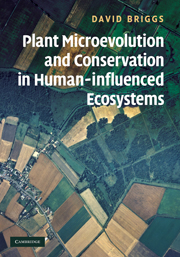Book contents
- Frontmatter
- Contents
- Preface
- Acknowledgements
- List of abbreviations
- 1 Introduction
- 2 Studying change
- 3 Key concepts in plant evolution
- 4 The origin and extent of human-influenced ecosystems
- 5 Consequences of human influences on the biosphere
- 6 Categories
- 7 Investigating microevolution in plants in anthropogenic ecosystems
- 8 Plant microevolution in managed grassland ecosystems
- 9 Harvesting crops: arable and forestry
- 10 Pollution and microevolutionary change
- 11 Introduced plants
- 12 Endangered species: investigating the extinction process at the population level
- 13 Hybridisation and speciation in anthropogenically influenced ecosystems
- 14 Ex situ conservation
- 15 In situ conservation: within and outside reserves
- 16 Creative conservation through restoration and reintroduction
- 17 Reserves in the landscape
- 18 Climate change
- 19 Microevolution and climate change
- 20 The implications of climate change for the theory and practice of conservation
- 21 Overview
- References
- Index
Preface
Published online by Cambridge University Press: 05 June 2012
- Frontmatter
- Contents
- Preface
- Acknowledgements
- List of abbreviations
- 1 Introduction
- 2 Studying change
- 3 Key concepts in plant evolution
- 4 The origin and extent of human-influenced ecosystems
- 5 Consequences of human influences on the biosphere
- 6 Categories
- 7 Investigating microevolution in plants in anthropogenic ecosystems
- 8 Plant microevolution in managed grassland ecosystems
- 9 Harvesting crops: arable and forestry
- 10 Pollution and microevolutionary change
- 11 Introduced plants
- 12 Endangered species: investigating the extinction process at the population level
- 13 Hybridisation and speciation in anthropogenically influenced ecosystems
- 14 Ex situ conservation
- 15 In situ conservation: within and outside reserves
- 16 Creative conservation through restoration and reintroduction
- 17 Reserves in the landscape
- 18 Climate change
- 19 Microevolution and climate change
- 20 The implications of climate change for the theory and practice of conservation
- 21 Overview
- References
- Index
Summary
It is often erroneously believed that evolution is something that happened in the past. However, there is strong evidence that evolution is continuing at the present time, as plants face new selection pressures generated by human activities that destroy, damage, fragment and alter ecosystems. In a world grappling with anthropogenic climate change, such pressures are likely to increase, as human populations, presently about 6.5 billion, are projected to rise to 12.8 billion by 2050 (if fertility remains at present levels).
In human-influenced landscapes, two broad classes of plants are often recognised, based on their apparent success or relative failure. Thus, some species are ‘winners’ (crop plants, weeds, invasive plants etc.). Others, the endangered species, are ‘losers’ or ‘potential losers’, with extinction their likely fate. Put simply, some plant species appear to be at a selective advantage in changing ecosystems and their populations are stable or increasing, while others faced with the same selection pressures are declining and threatened with extinction. Traditionally, but with some honourable exceptions, these two facets of evolutionary change are treated as separate subjects in academic books and elsewhere. Here, the notion of winners and losers is considered as a single concept, as major insights emerge through such an approach.
- Type
- Chapter
- Information
- Publisher: Cambridge University PressPrint publication year: 2009

